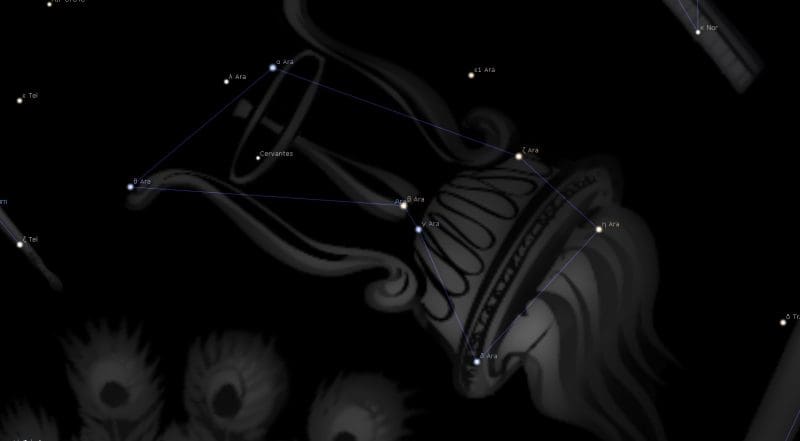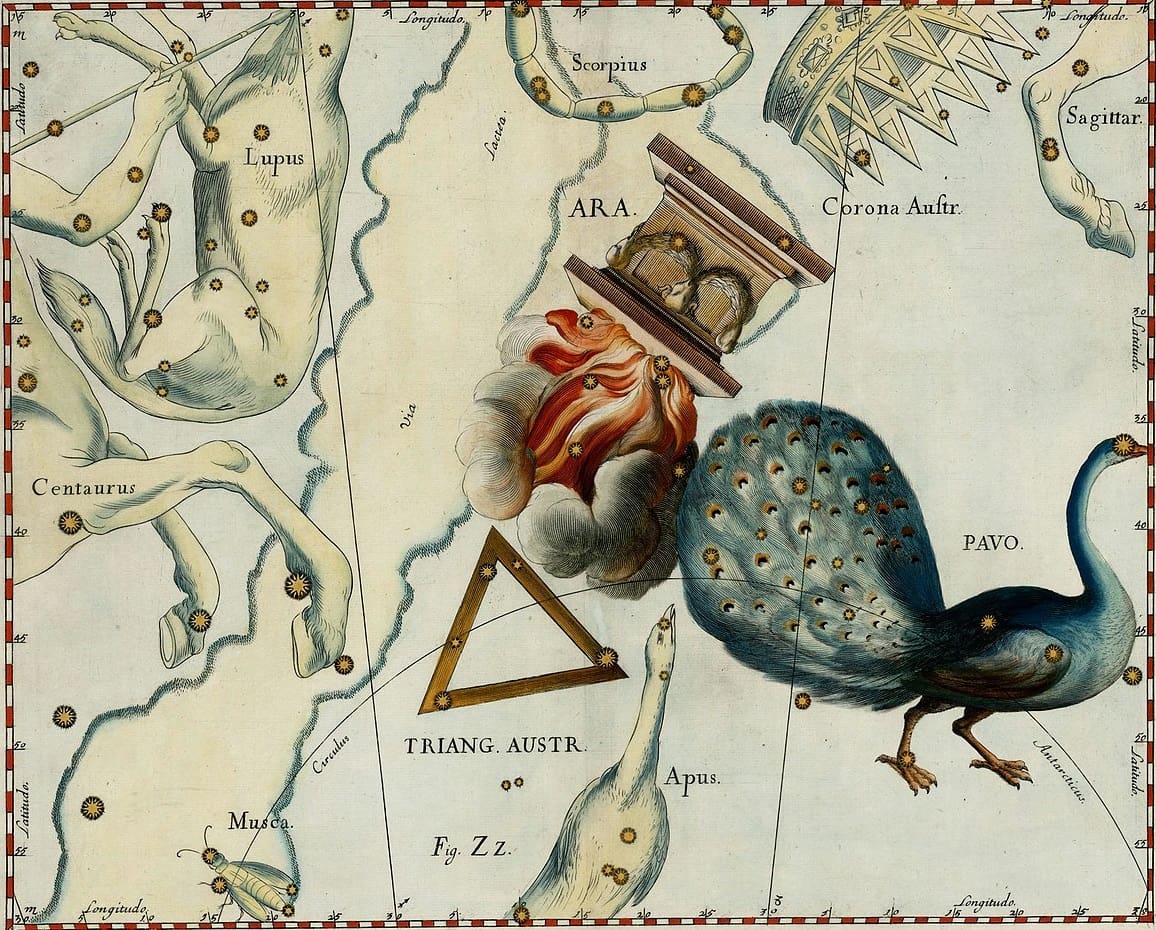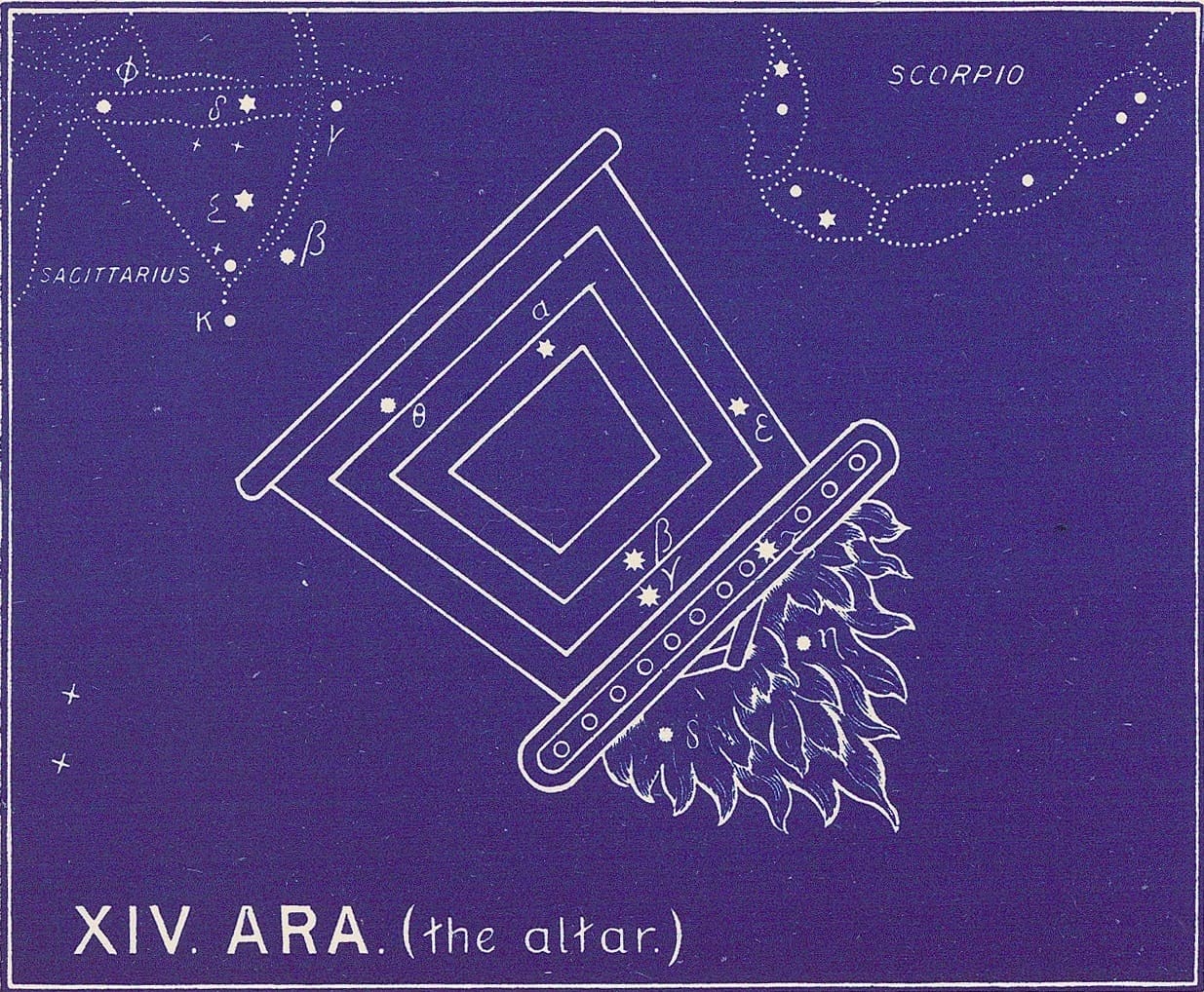FIXED STARS: Major Stars | 1000+ Stars | Constellations | About
Constellation Ara The Altar is a southern constellation bordering Scorpius, Norma, Triangulum Australe, Apus, Pavo, Telescopium, and Corona Australis.Ara is one of the 48 constellations listed by Ptolemy in the 2nd century and remains one of the 88 modern constellations. It spans over 12 degrees of the zodiac in the Sign of Sagittarius.
Abbreviation: Ara
Genitive: Arae
Ara Constellation Stars
| 2000 | 2050 | Star | Name | Sp. Class | Mag. | Orb |
|---|---|---|---|---|---|---|
| 18♐54 | 19♐36 | η Ara | K5 | 3.77 | 1°30′ | |
| 19♐34 | 20♐16 | ε1 Ara | Tso Kang | K4 | 4.06 | 1°20′ |
| 19♐49 | 20♐31 | ζ Ara | Korban | K5 | 3.12 | 1°50′ |
| 24♐12 | 24♐54 | β Ara | Karnot Mizbeach | K0 | 2.84 | 2°00′ |
| 24♐17 | 24♐59 | γ Ara | Zadok | B1 | 3.31 | 1°40′ |
| 24♐56 | 25♐38 | α Ara | Choo | B2 | 2.84 | 2°00′ |
| 25♐33 | 26♐15 | δ Ara | Tseen Yin | B8 | 3.60 | 1°40′ |
| 27♐13 | 27♐55 | μ Ara | Cervantes | G3 | 5.12 | 1°00′ |
| 01♑11 | 01♑53 | θ Ara | Tao Shou | B2 | 3.65 | 1°40′ |
α Ara was named Choo by Allen. [1] In Chinese, 杵 (Chǔ), meaning Pestle, refers to an asterism consisting of α Arae, σ Arae and β Arae. [2]
β Ara has the traditional name Karnot Mizbeach (or Karnothamizbeach ), which comes from the Hebrew meaning “trumpet of the altar.” [3] Rarely, this star is called Vasat-ül-cemre, a Turkisation of Arabic وسط الجمر (wasaṭ al-jamar), meaning “middle of the embers.” [4]
γ Ara has the traditional name Zadok (or Tzadok ), which comes from the Hebrew for “the righteous one”. Zadok (and his descendants) was also one of the high priests in Judea during the time of the Prophet Solomon until the time of the Maccabees. [3]
δ Ara is named Tseen Yin, derived from the Chinese 天陰, or Mandarin tiānyīn, “dark sky.” [3]
ε1 Ara is named Tso Kang, derived from Chinese 左更, or Mandarin zuǒgēng, “guard on the left.” [3]
ζ Ara has the traditional names Tseen Yin, derived from Chinese 天陰 or Mandarin tiānyīn, meaning “dark sky,” and Korban, derived from Hebrew, meaning “sacrifice.” [3]
θ Ara has the Chinese name Tao Shou, meaning “way of immortality.” [3]
μ Ara has the official name, Cervantes, after the famous Spanish writer Miguel de Cervantes. [5]
Ara Astrology
Maternus
Ara (the Altar) rises in the first degree of Scorpio. Those who are born when this star is rising with influence of benefic planets will be priests, prophets, temple attendants, ministers of the most sacred religions, or diligent interpreters of divine doctrine.
But if this star is at its setting and Mars and Saturn are in threatening aspect, the natives are sentenced for some kind of sacrilege. If Jupiter is in aspect, they are either sacrificed to the gods or killed in some religious rite.
Whoever has the ascendant in the first degree of Scorpio will be a magician who lessens hidden pains by the power of words.
Those who have the ascendant in Ara will make a living from sacrifices; they will die of burning. [6]
Ara Constellation [Hevelius]
Robson
Legend. During the war between the Gods and Titans, the Gods leagued themselves together and swore to withstand their enemies, confirming their oath upon an altar built for them by the Cyclops. After their victory the altar was taken up to heaven to commemorate the good resulting from unity. According to another account Ara was the altar on which the Centaur offered his sacrifices.
Influence. According to Ptolemy, its influence is similar to that of Venus and also Mercury in some degree. It is said to give aptness in science, egoism, devotion, and a love of ecclesiastical matters.
Magical. Gives chastity. [7]
Noonan
Ara is said to give aptitude in science, a devotion to God, and success in ecclesiastical matters. The α-star is called the Censer. When rising this star was said by Maternus in Mathesis to indicate priests, prophets, theologians, and others associated with religion. [8]
Allen
Ara, the Altar. It is located as Aratos described it
‘neath the glowing sting of that huge sign
The Scorpion, near the south, the Altar hangs;
and in classical times was intimately associated with Centaurus and Lupus, which it joined on the west before Norma was formed.
Thuribulum and Turribulum, a Censer, more correctly Turibulum, were customary titles down to the 18th century.
Pharus also appears, altars often being placed upon the summits of temple towers and thus serving the ancients as lighthouses, of which the Alexandrian Pharos was the great example.b
Its varied classical names show disagreement as to its form, yet great familiarity with its stars, on the part of early observers, with whom it was of importance as portending changes in the winds and weather;
Other details of this early Euphratean Altar are noted under Libra.
Ara is not wholly visible now north of the 23d degree of latitude; and its brief period above the horizon — only about four hours — explains Aratos’ allusion in our motto; his horizon being about the same as that of the city of New York.
Gould catalogues in it eighty-five stars, from 2.8 to the 7th magnitude; but none seem to be named except in China. There α, 2.9 magnitude, was Choo, a Club or Staff; and with β, γ, and ι, Low, Trailing.
With θ it marks the top of the Altar’s frame, culminating, on the 24th of July, just above the horizon in the latitude of New York, — 40°42′43″ at the City Hall.
Bayer’s map carries the latter star several degrees too far to the south-west; similar errors being found in others of his constellation figures of the southern heavens.
β, a 2.8‑magnitude, γ, δ, ε, and ζ mark the flame rising toward the south.
In China δ, 3.7, with ζ, was Tseen Yin, the Dark Sky; ε, a 4th‑magnitude, was Tso Kang, the Left Watch; and e 602 of Reeves was Tseen O, Heaven’s Ridge.
La Lande stated that a constellation was supposed to exist here, containing Ara’s stars, that was represented on the Egyptian sphere of Petosiris as a Cynocephalus. [1]
Bullinger
Here we have an altar or burning pyre, placed significantly and ominously upside down! with its fires burning and pointing downwards towards the lower regions, called Tartarus, or the abyss, or “outer-darkness.” It is an asterism with nine stars, of which three are of the 3rd magnitude, four of the 4th, etc. It is south of the Scorpion’s tail, and when these constellations were first formed it was visible only on the very lowest horizon of the south, pointing to the completion of all judgment in the lake of fire.
In the Zodiac of Denderah, we have a different picture, giving us another aspect of the same judgment. It is a man enthroned, with a flail in his hand. His name is Bau, the same name as Hercules has, and means He cometh. It is from the Hebrew Boh, to come. In Arabic, it is called Al Mugamra, which means the completing, or finishing. The Greeks used the word Ara sometimes in the sense of praying, but more frequently in the sense of imprecation or cursing. [9]
References
- Star Names: Their Lore and Meaning, Richard H. Allen, 1889, p.61-64.
- List of Chinese Star Names – Wikipedia.
- Ara – Wikipedia.
- Beta Arae – Wikipedia.
- Mu Arae – Wikipedia.
- Mathesis: Liber Octavus, XXIII 1-2, XXIX 15, Firmicus Maternus, 4th Century AD, p.278, 290, 291.
- Fixed Stars and Constellations in Astrology, Vivian E. Robson, 1923, p.29-30, 231.
- Fixed Stars and Judicial Astrology, George C. Noonan, p.74.
- The Witness of the Stars, E. W. Bullinger, 1893, Ara (the Altar).


